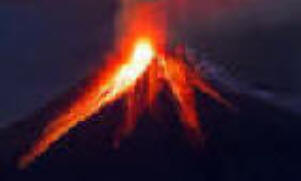Volcanos
Volcanoes are surface pictures to what is happening deep down in the earth. Volcanoes are mountains, but they are very different from other mountains; they are not formed by folding and crumpling or by uplift and erosion. Instead, volcanoes are built by the accumulation of their own eruptive products—lava, bombs (crusted over lava blobs), ash flows, and tephra (airborne ash and dust). A volcano is most commonly a conical hill or mountain built around a vent that connects with reservoirs of molten rock below the surface of the Earth. The term volcano also refers to the opening or vent through which the molten rock and associated gases are expelled.
Molten rock below the surface of the Earth that rises in volcanic vents is known as magma, but after it erupts from a volcano it is called lava. Originating many tens of miles beneath the ground, the ascending magma commonly contains some crystals, fragments of surrounding (un-melted) rocks, and dissolved gases, but it is primarily a liquid composed principally of oxygen, silicon, aluminum, iron, magnesium, calcium, sodium, potassium, titanium, and manganese. Magmas also contain many other chemical elements in trace quantities. Upon cooling, the liquid magma may precipitate crystals of various minerals until solidification is complete to form an igneous or magmatic rock.
There is what is called the Mantle where the great head that triggers volcanos is stored. The formation of magma occurs in only certain regions of the mantle by partial melting of the rock peridotite. Melting occurs either by the lowering of pressure in the mantle or by the lowering of the melting temperature of peridotite by introduction of water to the mantle from the Earth's surface during subduction.
